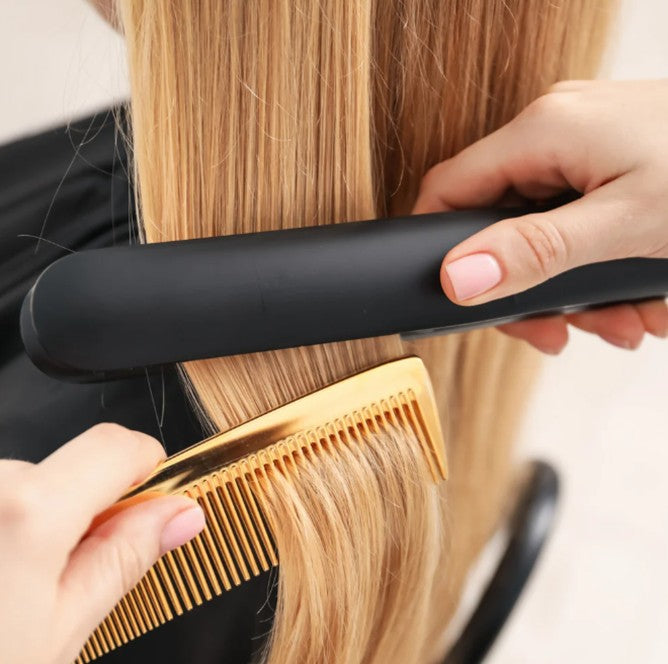How To Determine Your Hair Porosity
by BRENDA L. / 16 FÉVR. 2023

Reading Time: 5 Minutes
Index
We’ve talked a lot about hair structure, cuticles, cortex, and all the fascinating, scientific aspects of how your hair works and how it interacts with beauty products and styling; one thing you may have bumped into in our technical blogs is hair porosity, a topic that too often gets swept under the rug and not many fully understand. In this post, I’ll explain what hair porosity is, what it does, and most importantly: how to find out the level of porosity of your own tresses – so that you can make informed choices for your hair care routine. Ready? Read on to become the ultimate hair expert!
1. What Is Hair Porosity?
The term “porosity” it’s usually used to describe your hair’s ability to absorb and retain hydration. For example: that miraculous hair mask that works so well on your friend’s hair but doesn’t seem to do much to your strands? Yep, that could be due to a significant difference in your hair porosity. Your starting levels of hair porosity are mostly determined by genetics, and can be altered by using different hair products, using and abusing heat-based styling tools such as flat irons, blow-dryers and curling wands, and last but not least by over-processing your tresses with hair dye and bleach.
2. What Is Low Porosity Hair?
Low-porosity hair refers to tresses that don’t easily let moisture in. Usually, this can easily be determined under the shower: if your hair takes some time to get fully wet, it can be pinned on its low porosity, not allowing the water to soak your hair shaft. Out of the shower, low-porosity hair tends to repel products, making it harder to tame and style. Often people with low porosity find their hair is more resistant to hair dyes and bleach. To remedy this, colour technicians will adjust the timings, chemicals, process and in severe cases perform a service called ‘pre-softening’ before the colour is applied to open up the cuticles to allow the colour to deposit. If you already know your hair has low porosity its worth mentioning to your hair stylist before having your hair coloured as they will be able to prepare the products accordingly to get the best results!
3. What Is High Porosity Hair?
High-porosity hair, on the contrary, refers to hair with widely-spread cuticles. This type of hair feels quite rough compared to low-porosity hair, where a single strand usually feels softer and smoother (regardless of your hair’s texture). High-porosity hair quickly absorbs moisture but struggles in retaining it.
4. How To Check Hair Porosity?
If you’re curious about your own hair’s porosity, you can easily find out more about it with this simple test.
Grab a glass of water, then take a single hair out from your mane and dash it in the water, then observe:
- The hair quickly sinks to the bottom: your hair porosity is high.
- The hair sits somewhere in the middle before sinking: your hair porosity is medium.
- The hair stays on top of the water and takes longer before sinking: your hair porosity is low.
5. What Does Hair Porosity Mean?
Determining your hair porosity can help you to better understand how your hair works and responds to certain beauty products. Once you’ve checked your hair porosity thanks to the hair porosity test, read on to find out more about how to get the most of your tresses with the appropriate hair care routine.
6. How To Care For Low Porosity Hair:
There are quite a few things that you can implement in your hair care for low-porosity hair, and it won’t take long for you to notice the difference!
- Cut down on proteins. Focus on products that aim to moisturise instead of implementing hydrolyzed proteins such as keratin and/or biotin; hydrating products are usually easier to absorb and prevent product build-up that can cause your scalp to go greasy and irritated.
- Change your conditioner routine. Apply your conditioner on hair that is already soaking wet to ease the absorbing process. Applying heat during this procedure also helps lifting the hair cuticles, helping the conditioner to penetrate your hair. You can easily do this by wearing a shower cap whilst you wait.
- Stock-up on products with honey and glycerin. Avoid oil-based miracle potions that are unlikely to penetrate your hair cuticles, and focus on these thicker softening agents in your shampoo and conditioner.
7. How To Care For High Porosity Hair:
If you have just found out that your strands have high porosity levels, you’ll need to change your hair care routine to help it stay soft and moisturised.
- Focus on oils and butters. When choosing a hair product such as shampoo and conditioner, regular products that focus on hydration won’t quite cut it. Keep an eye on the ingredients’ list and make sure they are jam-packed with nourishing agents such as oils and butters.
- Use a leave-in conditioner. This miracle product helps your hair to stay soft and moisturised throughout your day, even when the softening effect of your under-the-shower conditioner may start to wear out.
- Avoid heat. Use lukewarm water under the shower when it’s time to wash your hair, and try heatless styling techniques such as the curling ribbon and air-drying when you can. You can read more about heatless styling here: How To Get Heatless Curls In 12 Easy Ways. When it comes to styling, if you can’t skip the use of a heat-based styling tool (or even the blow-drying process), make sure you use a generous amount of heat protectant. Cliphair’s Heat Protection spray offers a powerful shield to dissipate heat in your tresses, sheltering your hair cuticles from the damage of flat irons, curling wands and such.
- Seal your cuticles with oils. Different hair oils can provide different benefits, and one thing that they have in common is that they help to seal the cuticles of your hair, aiding it to retain moisture for longer. Find your secret helper in our dedicated blog: Hair Oil: Best Oils For Hair Growth And A Healthy, Happy Scalp.
8. Conclusion:
Hair porosity can affect the way your hair holds colour, moisture, and styling. Knowing how to treat your hair according to its levels of porosity can be a real game-changer for you and with these simple steps you can transform your hair care routine from basic to pro, and achieve brilliant results!
Looking for flawless, salon-worthy hair without breaking the bank? At Cliphair, we’ve got you covered with luxurious clip in hair extensions for quick transformations and permanent hair extensions for long-lasting glam. Extensions require special care and maintenance to preserve their quality, which is why we have all the top-notch hydrating haircare products needed to keep your style on point.
Need the perfect shade? Browse our full range of human hair extensions in over 70 rich, silky shades or check out our FREE Express Color Match Service to ensure a seamless blend every time.






